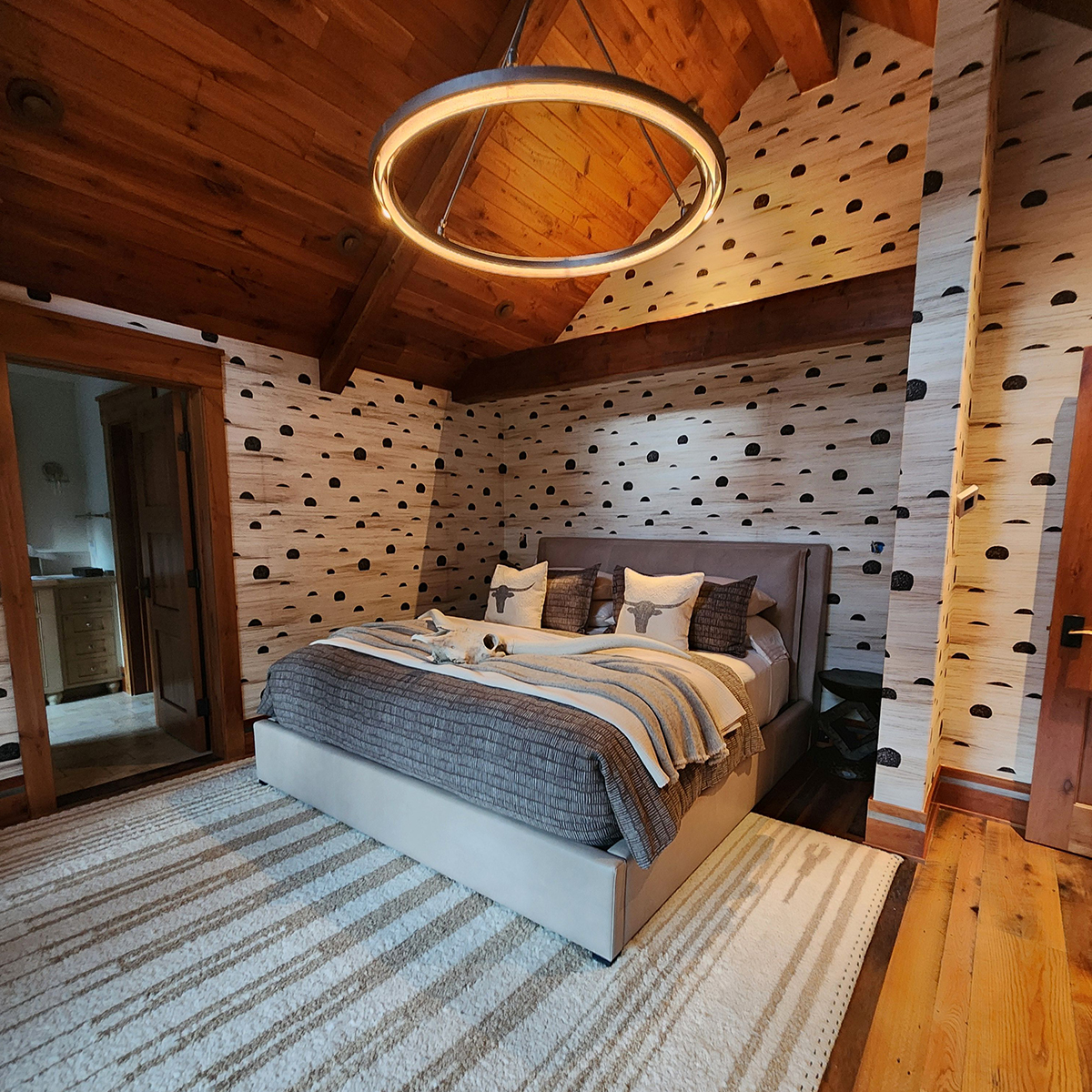One Family, Three Legacies
How the Perry Family Shaped Steamboat Springs
This article originally appeared in the Winter 2023 issue of Art with Altitude.
There are a few names that stand out when thinking about the development of Steamboat Springs: James Crawford, first permanent white settler; Buddy Werner, Olympic athlete; Jim Temple, who helped develop what is today called Mt. Werner. Yet there is one family who shaped three of the major industries that define Northwest Colorado, who don’t often get the credit they deserve: the Perry family.
Sam Perry was born in Knoxville, Illinois in 1849. He began his career working for the jewelry firm of N. Matson, where he met, and fell in love with, the boss’ daughter, Lottie Matson. Sam’s work ethic helped him move up to partner of the jewelry firm, but Lottie’s asthma pushed the couple to settle in Denver, Colorado. Sam wasted no time getting involved in real estate and in 1890 founded what today is known as Aurora, where he became intrigued with trains. His interest in trains ended up serving more than the Aurora community. He built an electric line connecting Aurora to Denver, which resulted in his appointment as vice president of the Denver Tramway Co.
In 1902, Sam’s business interests were sparked by the lure of coal seams in Routt and Moffat counties. He opened the Moffat Coal Co. at Oak Creek and for a time, there was consideration of naming what is now Phippsburg, Perryville. Knowing his friend and stockholder in the mines, David H. Moffat, was working on a train line that would run from Denver to the West Coast (the Denver & Salt Lake, or Moffat railroad), Sam worked on having the railroad come through Steamboat Springs instead of the original plans to run it south of the area. Sam’s influence, along with the eagerness of the Steamboat Springs Township to grow tourism and the population of the town by building a new depot, resulted in subscribers investing $15,000 for a train depot that welcomed its first passenger train in 1909. The population of Steamboat Springs doubled from 75 to 150 permanent residents within a year. Train service facilitated coal mining, which remains a key industry in Northwest Colorado, although it will be phasing out over the next several years.
Sam and Lottie had three children: Marjorie, Bobby and Charlotte. Bobby followed in his father’s footsteps and although he wanted to be a lawyer, he took over running the mines in Oak Creek. He died in his 40s, but not before he found love and had a family. His relatives are still prominent in both Denver and Carbondale today.
Where Bobby was reserved, his older sister reveled in challenging convention. Marjorie Perry loved her freedom as a single woman. She hunted with her father, was his right-hand man with his business, and was considered one of the best women sharpshooters in the country. She was known for skiing in front of the train (leaving Steamboat) in bad weather to guide the train on the tracks, and for riding her horse from Steamboat Springs to her Denver property when winter was about to settle in.
Her sense of adventure took her to Hot Sulphur Springs for their winter carnival in 1913, where she met a young ski jumper named Carl Howelsen. The two hit it off (some say as more than friends) when he taught her how to ski downhill in her big skirts and everything. She was enamored with the sport of skiing (up to that point, skiing was only used as a means of winter transportation) and convinced Carl to bring skiing and ski jumping to Steamboat Springs. That winter marked the first winter carnival, which today is the oldest winter carnival west of the Mississippi.
Carl built ski jumps on Woodchuck Hill, below where Colorado Mountain College sits today, and ski jumpers set new records for distance. And with that, Steamboat’s love of ski jumping was born. Today, Steamboat Springs boasts 100 Olympic athletes who have trained on the hill now named after Carl Howelsen, and his legacy lives on. Unfortunately, the romance between Carl and Marjorie fizzled when Carl met the woman who would become his future wife. She didn’t find the relationship between Carl and Marjorie nearly as endearing as they did, so he cut off ties with Marjorie when he moved away. For Marjorie’s contributions to skiing, she was inducted into the Colorado Ski Hall of Fame in 1988.
Last, but not least, came Charlotte Perry, the youngest daughter, who from her earliest years dreamed of being an actor, much to her father’s dismay (not helped by the fact that her father took her to the theatre and invited Opera singers, dancers and actors to their home in Denver). She attended Smith College and unlike many of the other women who were looking for husbands, Charlotte wanted to make a difference in the world. That passion connected her with another Smith College attendee, Portia Mansfield. Although Portia was a year ahead of Charlotte, the two hit it off and Charlotte invited her to join the Perry family for a bear hunt. It’s rumored that on that bear hunt, the two young women conceived of a camp high in the mountains where women could learn to dance, act and explore the arts as well as the wilderness. They worked and saved for two years before finally opening Rocky Mountain Dance Camp in Eldora, Colorado.
Unfortunately, the high altitude was a struggle for several of the dancers, as were the daily afternoon thunderstorms. And, not to mention the men from Denver who had heard there were nymphs dancing in the hills and would come up and sit on the opposite hill, watching the women with spyglasses. They knew the camp had to move, so they looked for a space closer to family. Bobby Perry found the site, out in Strawberry Park, where the camp was officially born. Today, Perry-Mansfield camp is the oldest continually running performing arts camp in the country, hosting the likes of Agnes de Mille, José Limón, Harriette Ann Gray, Julie Harris, Dustin Hoffman, Jessica Biel and so many more. Notable local alumni include Eleanor Bliss, who came out to dance, but fell in love with horseback riding, and began a lifelong friendship with Marjorie. When Eleanor moved to Steamboat Springs permanently, she was recruited by Carol Finnoff, who started the Steamboat Springs Arts Council, to bring art to the local community.
In 1968, after passenger train service ceased, the deed for the train depot was turned over to the City of Steamboat Springs. Eleanor Bliss spearheaded the efforts to turn the Depot into a center for the arts. Finally, in 1972, The Steamboat Springs Arts Council opened its doors, and today the Depot is home to the newest iteration of the arts council, Steamboat Creates, Steamboat Springs’ Creative District.
Another notable Perry-Mansfield alum is Lucille Bogue, who envisioned a college where people from around the world could come to share their ideas. With the help of Charlotte and Portia, she opened a four-year college in 1962, attracting people from as far away as Kenya and Argentina. In 1966, a permanent campus developed on Woodchuck Hill. The school folded shortly thereafter, but the campus remained and today it is home to Colorado Mountain College, which named Bogue Hall in Lucille’s honor.
The influence of the Perry family reaches around the globe and back. The family is responsible for the success of coal mining in the area, influencing David Moffat to bring the train to Steamboat Springs spurring the local economy, bringing recreational ski jumping to town—a defining feature of our community—and, of course, the legacy of arts and culture that continues to flourish today through opera, dance, music, theater, galleries, writers and more.
Elevate the Arts: Learn more about Steamboat’s history and heritage through the Tread of Pioneers Museum walking tours and by visiting the Bud Werner Memorial Library or Off the Beaten Path Bookstore.




